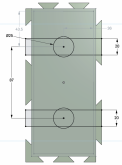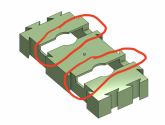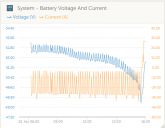Another real-world-like capacity test. A more desirable result this time.
8 Xuba 3.2V 280Ah cells (24V nominal) - Rated capacity 7,168Wh
Test Range
Upper limit: 27.15V (rested voltage)
Lower limit (under low C-rate load):
25.50V, 5,749Wh = 80% usable capacity
24.90V, 6,165Wh = 86% usable capacity
24.83V, 6,660Wh = 93% usable capacity
23.00V, 6,893Wh = 96% usable capacity
1st Pic - Test begins about 7:30am - Inverter off, rested 27.15V, reasonably balanced cells, zero'd Drok meter (right)

2nd Pic - Inverter powered on (left), uses about 40W on its own (no other loads), minor voltage drop

3rd Pic - I powered a bunch of stuff on - Coffee maker, refrigerator, desktop computer & monitors, stereo, osculating fan, TV & sound bar, laptop w/ docking station & monitors; All variously powered on & off throughout the day (also used the microwave for lunch & dinner).
Notice the voltage dropped from over 27V to less than 25V when the battery was mostly full. Over a 2V drop when putting a sizable load on the battery (1,830W or .25C rate). Something to keep in mind when setting the low-voltage alarm and low-voltage cut-off settings. When the battery capacity gets low and you're still wanting to use things like a microwave, toaster oven, coffee maker, window Air-conditioner, etc...., you may need to compensate using lower settings.

4th Pic - Reached 80% usable capacity at 25.5V under load

5th Pic - Reached 86% usable capacity at 24.9V under load

6th Pic - Reached over 92% at 24.87V under load

7th Pic - Inverter low-voltage alarm went off, I'd set it to 23.10V, battery went to just below 23V. I powered everything off. About 96% usable capacity. Test effectively ends about 10:30pm
Notice the voltage dropped from 24.87V to 22.95V in less than 30 minutes time with less than .1C discharge rate (<717W).
The lower limit dropped off quickly once below 24.8V.

8th Pic - Inverter is still on (no other loads). Notice the voltage bounces back to 23.5V after just a few minutes.

9th Pic - Inverter powered off, no load, voltage slowly leveling off

10th pic - 7:30am next morning, battery rested the whole night. Resting voltage leveled off at 24.2V.
So, from lower limit 23V under load to rested 24.2V in several hours time. Over a 1V rebound. Something to be aware of when using voltage as a general measure of the battery.
 Yeah, but what does all this mean???
Yeah, but what does all this mean???
It appears the Xuba 280V LiFePO4 cells are working as expected (advertised), at least from my experience so far. After a number of various capacity tests and a learning-curve on my part, the cells seem to be working well for off-grid solar power usage (low C-rates).
One thing I'm not sure about is high C-rates. I haven't really tried rates much above .25C (<2kW). Mainly, because what I've been testing with is a power system temporarily put together, using 1 AWG cable with uncrimped lugs, stock bus bars, and a couple of 50ft extension cords and power strips. The seemingly significant voltage drop under higher loads could be because of my improvised setup (not very efficient).
For me, it looks like the cells are going to work for what I have planned (ie. hurricane season backup power & general DIY hobby use). I was aiming for 10kW potential usable power.
16 Xuba 3.2V 280Ah cells (24V nominal) - Rated capacity 14,336Wh
Rough (ball park) estimates:
14kW x 85% = 12kW Battery charged to about 85% capacity (range somewhere between 27.2V - 24V)
12kW x 85% = 10kW Efficiency & Inverter DC to AC conversion losses (average about 15% loss)
I think a reasonable balance between available usable power and good battery longevity.
Thanks Sgt Raven and Steve_S for the backup suggestions when making long posts. I did both, used a text editor and the disk icon (Save draft) feature. Didn't need them this time, but good peace-of-mind, though.













